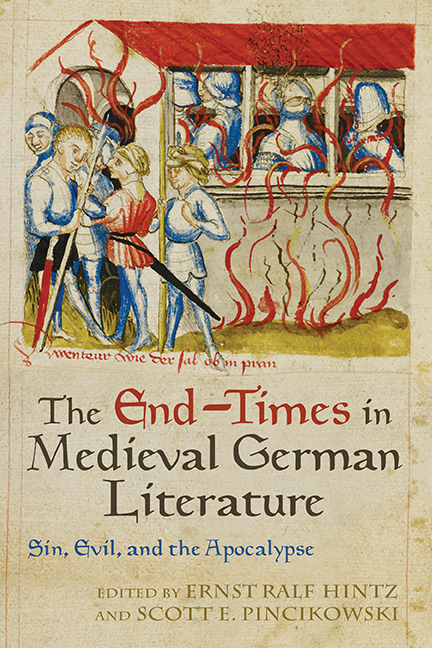Book contents
- Frontmatter
- Dedication
- Contents
- Acknowledgments
- Introduction
- 1 Thiu wirsa giburd: Cain’s Legacy, Original Sin, and the End of the World in the Old Saxon Genesis
- 2 The Heliand Revisited: Spiritual Transgendering and the Defiance of Evil
- 3 The Beginning of the End: Binary Dynamics and Initiative in Hartmann von Aue’s Gregorius
- 4 Poetic Reflections in Medieval German Literature on Tragic Conflicts, Massive Death, and Armageddon
- 5 Beyond Good and Evil: Apocalyptic Vision without Judgment in the Nibelungenlied. An Essay
- 6 End-Times in the Hall: The Modern Reception of the Apocalyptic Ending of the Nibelungenlied
- 7 Past Present, Future Present? Visualizing Arthurian Romance and the Beholder’s Share in a World That Refuses to End
- 8 Ich diene und wirbe / biz ich gar verdirbe: Lovesickness, Apocalypse, and the End-Times in Mauritius von Craûn and Das Nibelungenlied
- 9 The Slippery Concept of Evil in Hartmann von Aue’s Erec and Iwein
- 10 Wigamur’s Lessons on the Complexity of Evil
- 11 The Miracles of the Antichrist
- 12 Monsters and Monstrosities in the Pamphlet Wars of the Reformation
- Notes on the Contributors
- Index
7 - Past Present, Future Present? Visualizing Arthurian Romance and the Beholder’s Share in a World That Refuses to End
Published online by Cambridge University Press: 21 March 2020
- Frontmatter
- Dedication
- Contents
- Acknowledgments
- Introduction
- 1 Thiu wirsa giburd: Cain’s Legacy, Original Sin, and the End of the World in the Old Saxon Genesis
- 2 The Heliand Revisited: Spiritual Transgendering and the Defiance of Evil
- 3 The Beginning of the End: Binary Dynamics and Initiative in Hartmann von Aue’s Gregorius
- 4 Poetic Reflections in Medieval German Literature on Tragic Conflicts, Massive Death, and Armageddon
- 5 Beyond Good and Evil: Apocalyptic Vision without Judgment in the Nibelungenlied. An Essay
- 6 End-Times in the Hall: The Modern Reception of the Apocalyptic Ending of the Nibelungenlied
- 7 Past Present, Future Present? Visualizing Arthurian Romance and the Beholder’s Share in a World That Refuses to End
- 8 Ich diene und wirbe / biz ich gar verdirbe: Lovesickness, Apocalypse, and the End-Times in Mauritius von Craûn and Das Nibelungenlied
- 9 The Slippery Concept of Evil in Hartmann von Aue’s Erec and Iwein
- 10 Wigamur’s Lessons on the Complexity of Evil
- 11 The Miracles of the Antichrist
- 12 Monsters and Monstrosities in the Pamphlet Wars of the Reformation
- Notes on the Contributors
- Index
Summary
A WEALTH OF SCHOLARSHIP has documented how much European medieval culture liked to surround itself with the imagined past of romance, whether in painted chambers or on wall murals, whether on jewelry caskets or on tapestries. The enthusiasm only increased over time; eventually, says Anne Dunlop, “romance tales covered acres of Italian walls.” These visualizations of romance translated narrative into three dimensions, allowing their patrons to live with the images and with the story. When we consider some of the earliest depictions of romance, like the Ywain murals at Rodenegg, we might recall Michael Camille's description of how Gothic art encouraged the participation of its viewers in new ways of seeing and experiencing temporality and space. Camille describes Gothic art as a polyvalent mode of discourse “rooted in a plastic, three-dimensional attitude to space” that offered “a world of incredible intensity and color, constructing richly embellished three-dimensional objects into which people could enter psychologically” (180–83). The cathedral exemplifies this polyvalence, transmitting a sense of becoming in which past, present, and future form a continuum whose “contiguity, through the Gothic building, yields a higher synthesis.” Such a building seems to ensconce in stone the presentness of time expressed centuries before by Augustine in book 11 of his Confessions; musing on the nature of time, Augustine concludes that the categories of past, present, and future are insufficient: “What is now plain and clear is that neither future nor past things are in existence, and that it is not correct to say there are three periods of time: past, present and future. Perhaps it would be proper to say there are three periods of time: the present of things past, the present of things present, the present of things future.” In this essay I would like to reflect on two examples from the thirteenth century that I believe illustrate and exploit the elasticity of medieval time to make the past present: the Ywain murals at Rodenegg and the Stifterfiguren (donor portraits) of Naumburg cathedral. I argue that both of these examples bring an imagined past into the audience's present by activating what art historian Ernst Gombrich terms the “beholder's share.” The beholder's share is “our” share “in the reading of the artist's image.”
- Type
- Chapter
- Information
- The End-Times in Medieval German LiteratureSin, Evil, and the Apocalypse, pp. 144 - 167Publisher: Boydell & BrewerPrint publication year: 2019



